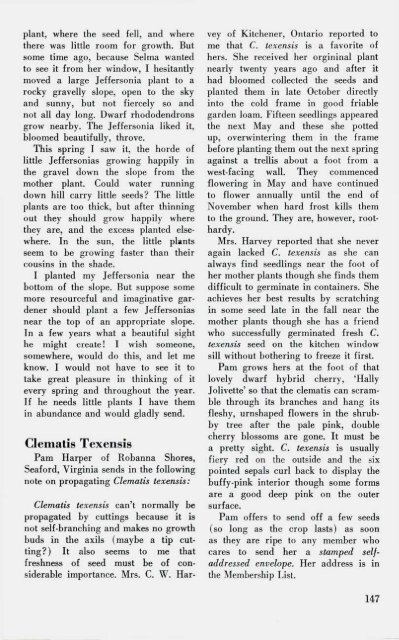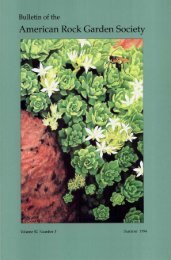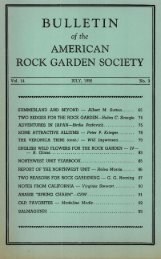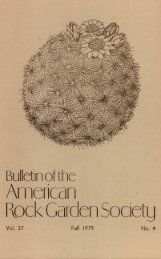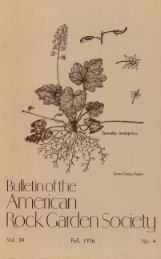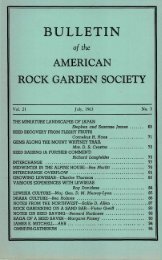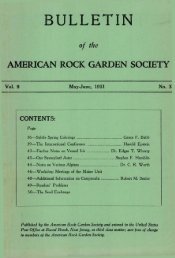Bulletin - Summer 1979 - North American Rock Garden Society
Bulletin - Summer 1979 - North American Rock Garden Society
Bulletin - Summer 1979 - North American Rock Garden Society
You also want an ePaper? Increase the reach of your titles
YUMPU automatically turns print PDFs into web optimized ePapers that Google loves.
plant, where the seed fell, and wherethere was little room for growth. Butsome time ago, because Selma wantedto see it from her window, I hesitantlymoved a large Jeffersonia plant to arocky gravelly slope, open to the skyand sunny, but not fiercely so andnot all day long. Dwarf rhododendronsgrow nearby. The Jeffersonia liked it,bloomed beautifully, throve.This spring I saw it, the horde oflittle Jeffersonias growing happily inthe gravel down the slope from themother plant. Could water runningdown hill carry little seeds? The littleplants are too thick, but after thinningout they should grow happily wherethey are, and the excess planted elsewhere.In the sun, the little plantsseem to be growing faster than theircousins in the shade.I planted my Jeffersonia near thebottom of the slope. But suppose somemore resourceful and imaginative gardenershould plant a few Jeffersoniasnear the top of an appropriate slope.In a few years what a beautiful sighthe might create! I wish someone,somewhere, would do this, and let meknow. I would not have to see it totake great pleasure in thinking of itevery spring and throughout the year.If he needs little plants I have themin abundance and would gladly send.Clematis TexensisPam Harper of Robanna Shores,Seaford, Virginia sends in the followingnote on propagating Clematis texensis:Clematis texensis can't normally bepropagated by cuttings because it isnot self-branching and makes no growthbuds in the axils (maybe a tip cutting?)It also seems to me thatfreshness of seed must be of considerableimportance. Mrs. C. W. Harveyof Kitchener, Ontario reported tome that C. texensis is a favorite ofhers. She received her orgininal plantnearly twenty years ago and after ithad bloomed collected the seeds andplanted them in late October directlyinto the cold frame in good friablegarden loam. Fifteen seedlings appearedthe next May and these she pottedup, overwintering them in the framebefore planting them out the next springagainst a trellis about a foot from awest-facing wall. They commencedflowering in May and have continuedto flower annually until the end ofNovember when hard frost kills themto the ground. They are, however, roothardy.Mrs. Harvey reported that she neveragain lacked C. texensis as she canalways find seedlings near the foot ofher mother plants though she finds themdifficult to germinate in containers. Sheachieves her best results by scratchingin some seed late in the fall near themother plants though she has a friendwho successfully germinated fresh C.texensis seed on the kitchen windowsill without bothering to freeze it first.Pam grows hers at the foot of thatlovely dwarf hybrid cherry, 'HallyJolivette' so that the clematis can scramblethrough its branches and hang itsfleshy, urnshaped flowers in the shrubbytree after the pale pink, doublecherry blossoms are gone. It must bea pretty sight. C. texensis is usuallyfiery red on the outside and the sixpointed sepals curl back to display thebuffy-pink interior though some formsare a good deep pink on the outersurface.Pam offers to send off a few seeds(so long as the crop lasts) as soonas they are ripe to any member whocares to send her a stamped selfaddressedenvelope. Her address is inthe Membership List.147


